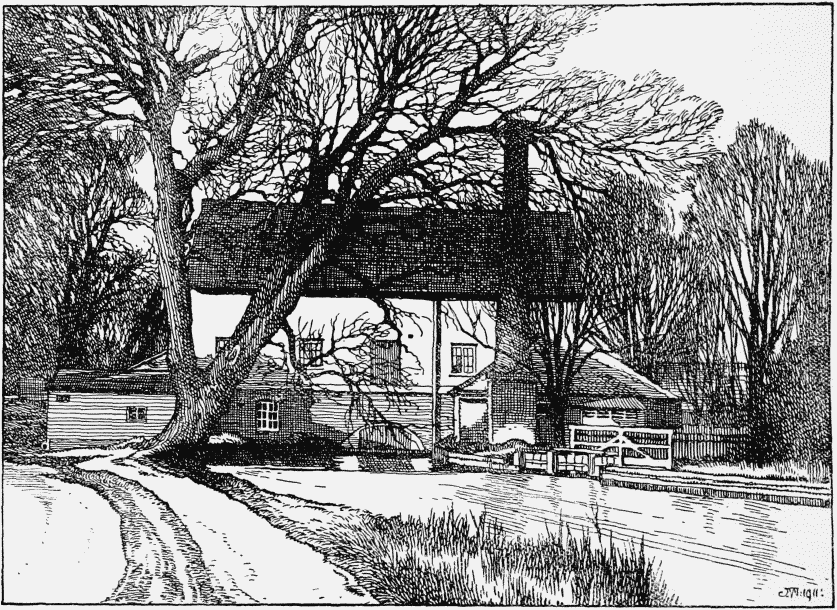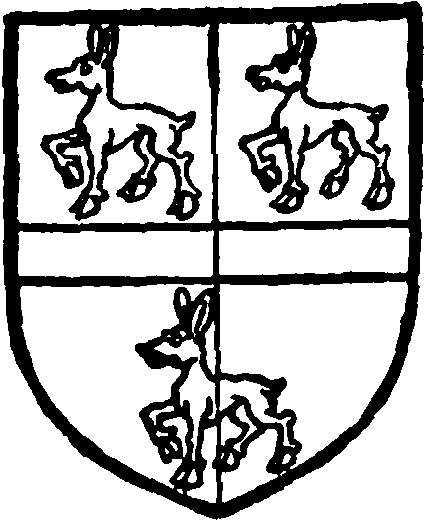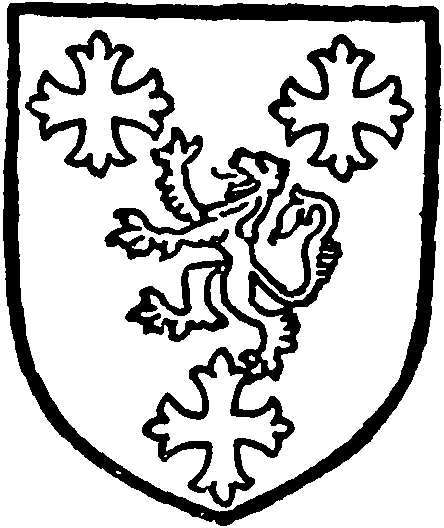A History of the County of Hertford: Volume 3. Originally published by Victoria County History, London, 1912.
This free content was digitised by double rekeying. All rights reserved.
'Parishes: Thundridge', in A History of the County of Hertford: Volume 3, ed. William Page (London, 1912), British History Online https://prod.british-history.ac.uk/vch/herts/vol3/pp377-380 [accessed 24 April 2025].
'Parishes: Thundridge', in A History of the County of Hertford: Volume 3. Edited by William Page (London, 1912), British History Online, accessed April 24, 2025, https://prod.british-history.ac.uk/vch/herts/vol3/pp377-380.
"Parishes: Thundridge". A History of the County of Hertford: Volume 3. Ed. William Page (London, 1912), British History Online. Web. 24 April 2025. https://prod.british-history.ac.uk/vch/herts/vol3/pp377-380.
In this section
THUNDRIDGE
Tonrich (1086); Tunrigge, Thanrugge, Thornrugge (xiii cent.); Thunrigge, Thunrych, Thurrich (xiv and xv cent.); Thundriche (xvi cent.).
Thundridge is a small parish of 2,206 acres bounded on the north-west by the River Rib, which divides it from the parish of Standon, and on the north-east by the Nimney Bourne. The main road to Buntingford intersects the parish on the west. Of the total area rather more than half is arable land, but there is a considerable amount of pasture in the valley of the Rib. The chief woods are Sawtres Wood on the north in the bend of the river, Steere Wood further south, and Buckney Wood to the south of this. Gardiner's Spring, a small wood to the west of Buckney Wood, preserves the name of the 17th-century owners of the manor. The land rises from the valley of the Rib on the north and is for the most part between 200 and 300 ft. above the ordnance datum. The soil varies, the subsoil being gravel and clay. No inclosure award has been made for the parish. Burleigh Common and Halfyard Common are still in several ownership, but Ashridge Common, which from its name must have been an open field, is now owned by one person only. All three are arable. (fn. 1)
There is no village of Thundridge properly speaking; all that remains of the original settlement are a 17th-century chimney stack of brick which belonged to the manor-house called the Bury (pulled down in 1812), (fn. 2) the ruins of a cottage which once formed part of the stables of the Bury, and the tower of the old church, all situated close together in a bend of the river about half a mile east of the Buntingford road. The church is surrounded by fine chestnut trees, pines and yews, and in summer the spot is beautiful in spite of its deserted appearance. To the south of the church is Thundridge Hill, the slope of which is occupied by a long field planted with lines of elm trees. Leading to the church from the west is an avenue of elms known as the Causeway. This at the further end is continued to Wadesmill by a picturesque path along the side of the river.
The hamlet of Wadesmill is built along the road to Buntingford and lies partly in the parish of Thundridge and partly in High Cross (formed from the ancient parish of Standon), the bridge over the Rib forming the boundary. The part of the village on the eastern bank of the river is known locally as Thundridge. The church of St. Mary occupies a good position on high ground further along the road to the south. The vicarage stands some little distance from it in Poles Lane. The main street of the village was the street parallel with the main road, now known as Back Street. The main road is said to have run along here before it was diverted to its present route, this new part of it being still known as New Road. (fn. 3) In Back Street is the old White Hind Inn and next to it stood the smithy, now pulled down. A row of cottages on the same side as the 'White Hind' was built by Mr. Hanbury in 1888. The mixed elementary school on the other side of the road was built in 1900, superseding one opposite the church which is now used as a reading-room. The infants' school near the church was opened in 1894, taking the place of one which stood in front of the present house. The situation of the hamlet on the main road to Cambridge brought much traffic through it when travelling was by coach. At the beginning of the 19th century more than 100 horses were often stabled at the Feathers Inn on the other side of the bridge. The turnpike at Wadesmill was one of the first three put up in the county. (fn. 4)
Poles, on the north-west of the parish, is the seat of Mr. E. S. Hanbury; the house, which is modern, stands in a park of about 100 acres. Swangle's Farm, to the south-east of the old church, preserves the name of a family of Swangle who appear in the neighbourhood in the 14th century. (fn. 5) On the southeast of the parish is a farm called Castlebury. The original form of this name is Casewellbury. At the end of the 15th century there is record of a mill called Casewell Mill, (fn. 6) and in 1694 half a messuage or farm called Casewelbury, or Casewelbury, was sold by Humphrey Taylor, citizen and mercer of London, to Sir Henry Wincombe of Bucklebury, co. Berks., bart. (fn. 7) From Castlebury a by-road runs south-west to Newhall Green in Ware parish and east to Baker's End in Thundridge. Baker's End (fn. 8) communicates by road with Nobland Green on the north-east and with Rush Green on the north by a road which passes through Halfyard Common. The number of these small greens in the neighbourhood is noticeable.
Anastasius Cottonus Jacksonus Lightfoot, son of John Lightfoot, rector of Great Munden, the Hebrew scholar and Biblical critic (and named after his father's friends Sir Rowland Cotton and Sir John Jackson), became vicar of Thundridge in 1661. Another divine of some note, William Webster, was instituted in 1740. He was a voluminous writer, chiefly of theological works, but in 1740 he published a pamphlet on the woollen manufactory from materials furnished by a merchant in the trade called The Consequences of Trade to the Wealth and Strength of any Nation, by a Draper of London, which had a large sale; this he followed next year by a refutation of his own arguments called The Draper's Reply.
MANORS
Thundridge
Before the Conquest the manor of THUNDRIDGE, sometimes called WADESMILL, was held by Alnod under Stigand, Archbishop of Canterbury. In 1086 it formed part of the possessions of Odo Bishop of Bayeux, of whom it was held by Hugh de Grentmesnil. It was assessed at 1 hide only. There was land for four ploughs, but there were only three on the manor, one of which was on the demesne; there was meadow for four plough-teams, woodland for sixteen swine, and a mill (fn. 9) (possibly on the site of Wadesmill). After the forfeiture of the Bishop of Bayeux the manor was held of the king in chief by the successors of Grentmesnil, and this tenancy follows the descent of the manor of Ware (q.v.).

Wades Mill, Thundridge
In the 13th century the immediate tenants of the manor were the family of Dive of Balderton, co. Nottingham, and Kingerby, co. Lincoln. It was held by William de Dive, who died before 1251, when his heir John was under age and a third of the manor was held in dower by his widow Ermentrude. (fn. 10) In 1277 John Dive obtained a grant of free warren in his demesne lands of Thundridge. (fn. 11) John died seised in 1292–3, leaving two sisters, Joan then the wife of Ralph de Trehamtone and apparently widow of Sir William Disney, (fn. 12) and Elizabeth, then wife of John D'Aubyn. (fn. 13) The extent of the manor is given as a messuage and dovecote, 1 carucate of land, 10 acres of meadow, 30 acres of wood, 40 acres of pasture, with rents of assize and rents from customary tenants. (fn. 14) In the following year Elizabeth died holding half the manor, (fn. 15) leaving a son Sir Hugh de Bussy, kt., by a former marriage. Apparently this half was acquired by the other heirs, for there seems to be no further trace of it. In 1303 Joan the second heir, then a widow, conveyed her part of the manor to Adam de Swillington for life. (fn. 16) Afterwards, before 1312, she married Adam de Swillington (fn. 17) (of Swillington, near Leeds), with whom she was jointly seised. He obtained a grant of free warren in February 1327–8 (fn. 18) and died in or before 1330. (fn. 19) The manor then passed to Sir William Disney, apparently the son of Joan by her first marriage. He in 1347 settled it on his son and daughter-in-law William and Joan Disney. (fn. 20) From William the younger it passed to Sir William Disney, his son, (fn. 21) to John of Norton Disney, co. Lincoln, son of William, who was killed at Towton in 1461, (fn. 22) and to his grandson and heir William, who died seised of it in 1540. (fn. 23) Richard, his son and heir, conveyed it in 1543 to John Gardiner of London and his wife Joan. (fn. 24) John Gardiner died in 1555. His son Thomas died without issue and the manor passed to his brother Henry, who had two sons Henry and James. After the death of Henry, James conveyed it to his nephew Edward Gardiner, son of his sister Elizabeth by Simon Gardiner her first cousin. (fn. 25) Edward was sheriff of the county in 1628 (fn. 26); he died in 1650, leaving a son Edward, who also served as sheriff in 1657. (fn. 27) On his death in 1664 Thundridge descended to a younger son John, and then, according to Chauncy, to his son Henry, who died in 1693, and to Henry son of Henry, the owner in 1700. (fn. 28) Clutterbuck, however, gives a rather different account, making the manor descend to John, the fourth son of the abovementioned John, to John his son, who died in 1760, to another John his son, and then to Gilbert son and heir of John. Gilbert Gardiner sold part of the estate called Poles, and later another part called Downfield, (fn. 29) and in 1811 he with Dorothy Gardiner, widow of John, sold the manor with the mill at Wadesmill to Daniel Giles of Youngsbury. (fn. 30) It then descended with Youngsbury in Standon (q.v.), and Mr. C. B. Giles-Puller of Youngsbury is the present lord of the manor.

Gardiner. Party or and gules a fesse between three hinds tripping all counterchanged.

Turner. Or a lion between three crosses paty gules.
Sawtres
The manor of SAWTRES (Sawtrey, Sawtrees), an estate on the north of the parish, situated in the bend of the River Rib, was held of the manor of Ware. At the beginning of the 15th century it seems to have belonged to Sir Nicholas Thorley, kt., and to have passed from him to his kinsman and heir Walter Estoft, who conveyed it in 1451 to John Viscount Beaumont and others. (fn. 31) In 1533 Walter Wadeland and Thomas Montgomery conveyed it to Richard Welles and others. (fn. 32) Francis Roberts died seised of it in 1632, his grandson Sir William Roberts, son of his son Barn, being his heir. (fn. 33) Sir William Roberts, called of Willesden, co. Middlesex, sold the manor and capital messuage in 1638 to Robert Turner, D.D., canon residentiary of St. Paul's Cathedral, (fn. 34) excepting three copyholds in Ware and an acre of land in Ware Park. It descended to Thomas Turner, Dean of Canterbury, and to his son Francis Turner, Bishop of Rochester 1683–4, Bishop of Ely in 1684 (afterwards suspended from the latter bishopric for refusing to take the oath of allegiance to William and Mary), who in 1695 sold the manor to Richard Crawley of London. (fn. 35) After this the descent of the manor is fragmentary. Jane Smith suffered a recovery of it in 1732, (fn. 36) Edmund Pepys and his wife Sarah did the same in 1765, (fn. 37) and Lee Steere Steere in 1824. (fn. 38) It was acquired from the Steere family about forty years ago by Mr. Arthur Giles-Puller, and has since descended with the Youngsbury estate (Standon, q.v).
CHURCH
The church of ST. MARY at Wadesmill consists of chancel 26 ft. 9 in. by 20 ft. 9 in., north vestry, nave 56 ft. 9 in. by 25 ft., and west tower; all internal dimensions. The church was built in 1853 of squared rubble with stone dressings, to take the place of the old church, of which only the tower remains.
The old church was pulled down in 1853 on the erection of the church at Wadesmill. There was a chapel here in the time of Hugh de Grentmesnil, who was tenant in 1086. (fn. 39) The dedication is given variously as ALL SAINTS (fn. 40) and ST. MARY. Chauncy says it was called Little St. Mary's. (fn. 41) The tower is built of flint rubble with stone dressings, and is of three stages, with angle buttresses on the west; it was erected in the 15th century. The tower arch is blocked and the stonework much defaced. Under the arch has been inserted a 12th-century doorway with semicircular arch, with cheveron and billet mouldings, all much decayed; above the doorway a 14th-century window has been inserted. It has two trefoiled lights with tracery under a square head; it is in good condition. Both doorway and window appear to have come from the old church. On the south wall, in the first stage, is a square panel inclosing a quatrefoil piercing with a rose in the centre; in the west wall is a doorway with a four-centred arch under a square head, with tracery in the spandrels, and above it is a window of three cinquefoiled lights under a fourcentred arch. The second stage has narrow single lights on the north, south and west faces and a sundial on the south. Each face of the belfry stage has a window of two trefoiled lights with a quatrefoiled opening in the head, under a four-centred arch. The tower has been buttressed on the east, and the upper stages are secured with iron bolts.
The bells, of which there are four, are now in the modern church. The treble is inscribed 'Johannes est nomen ejus' by an unknown founder; the second is dated 1623; the third 1631, both by Robert Oldfeild; the fourth by John Dier, 1580.
The communion plate consists of flagon, 1775, cup, 1837, and paten, 1837.
The registers are in five books as follows: (i) baptisms, burials and marriages 1556 to 1670; (ii) baptisms, burials and marriages 1682 to 1738; (iii) baptisms and burials 1738 to 1812, marriages 1738 to 1751; (iv) marriages 1754 to 1806; (v) marriages 1806 to 1812.
ADVOWSON
The advowson of the old church of ST. MARY follows the descent of the advowson of Ware (q.v.), to which church it was a chapel. Hugh de Grentmesnil gave both church and chapel to the Priory of Ware. In the composition made between the parishioners of Ware and Thundridge and the Prior of Ware in 1231 (see advowson of Ware) it was agreed that the Prior and vicar of Ware should serve the church daily by a chaplain, who should reside there and who should be provided by the parishioners with a house, 4 acres of arable land, 1d. every Sunday with blessed bread, 2s. in Christmas week or bread to that value, and 3s. 2d. per annum. (fn. 42) After the Dissolution the advowson came with that of Ware to Trinity College, Cambridge. The church was served by a vicar of its own until 1781, when the vicarage was consolidated with that of Ware. (fn. 43)
In 1810 the parsonage and glebe land were sold for the redemption of the land tax with which the vicarage was charged, and the house was then pulled down. (fn. 44) When the church of St. Mary was built by Mr. Hanbury in 1853 the Master and Fellows of Trinity College gave him the advowson, reserving the great tithes. The vicarage was then again separated from Ware and a residence built for the vicar. (fn. 45) Mr. E. S. Hanbury is the present patron.
CHARITIES
The charity of Jane Wall, founded by will dated in 1573, is regulated by schemes of the Charity Commissioners 1862 and 1875. The property originally consisted of about 19 a. of land in Thundridge and 4 a. 2 r. of land in Much Munden. The land at Thundridge was exchanged under the Act of 1 & 2 George IV for 25 a. 1 r. 37 p. of land situate near Nobland Green. The real estate has been sold from time to time, and the trust fund now consists of £2,126 9s. 9d. consols with the official trustees, producing £53 3s. yearly.
The charity of an unknown donor, which is regulated by a scheme of the Charity Commissioners 14 December 1909, consists of an annual rent-charge of 40s. issuing out of the Youngsbury estate.
The income of these two charities was applied in 1909 as to £22 10s. in clothing tickets to about forty-eight families, £18 in bread tickets to fifty families, £5 to parish nurse, and £9 10s. in scholarships and assistance to children leaving school.
In 1908 Miss Katharine Jane Green, by her will proved at London 24 November, gave £40 consols, the interest to be applied in coals to be given at Christmas, and equally divided between the six oldest poor women, either widows or spinsters. The stock is held by the official trustees.